note Note générale
On Care of our Commons Home: Storying the Commons
This note is part of the Commoning Beyond Growth Workshop, which took place in Nottingham from June 5 to 7, 2024.
Cette note s'inscrit dans le colloque le Commoning au-delà de la croissance, qui a eu lieu à Nottingham du 5 au 7 juin 2024.
💡 Une traduction de la note en français est disponible plus bas.
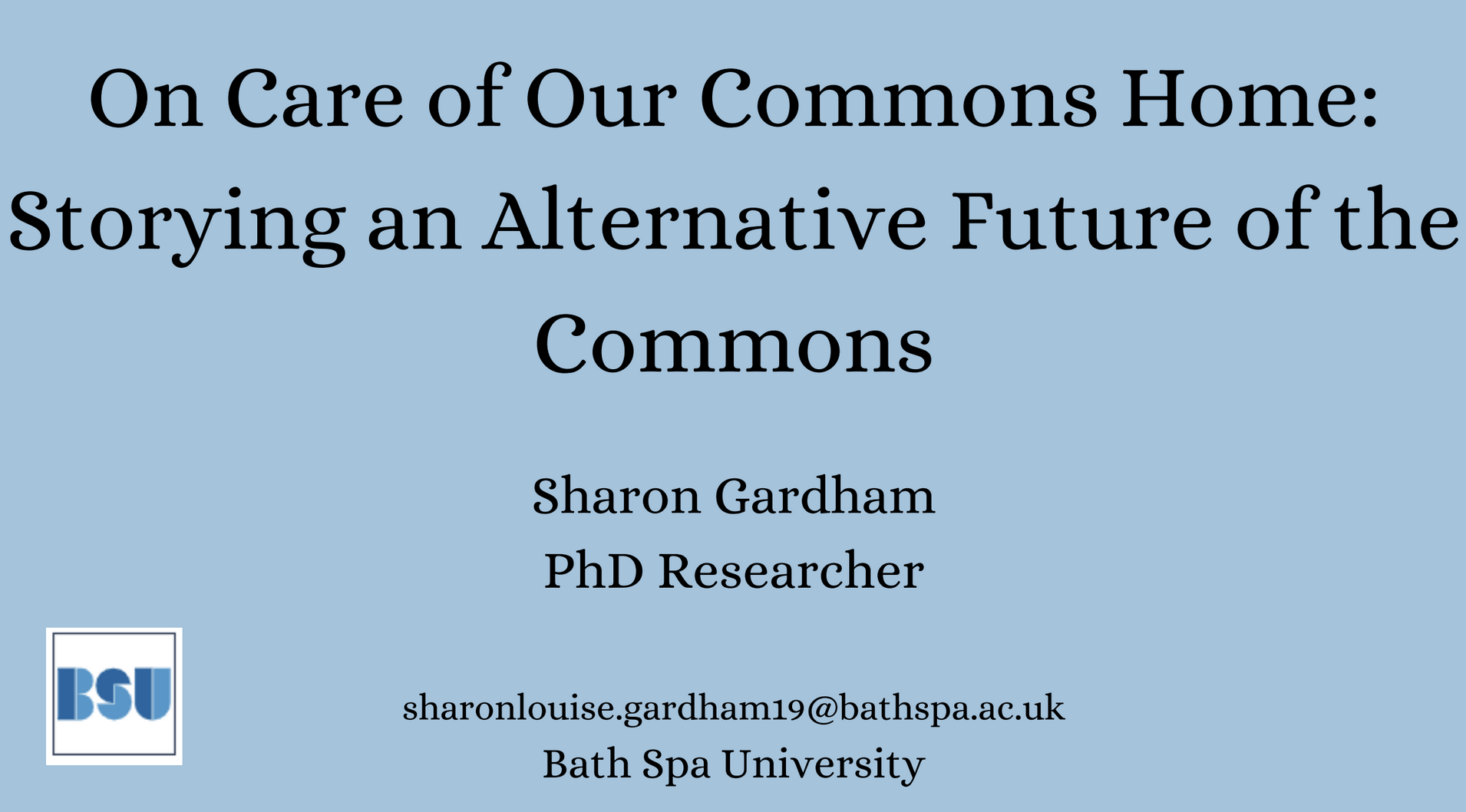
Hello and good afternoon. My name is Sharon Gardham and I am in my final year of PhD research at Bath Spa University. My project ‘On Care of our Commons Home: Revitalising and Extending the Notion of Good Neighbourhood for the Modern Cotswold Commons’ is based in the disciplines of the Environmental Humanities. It uses historical research, discourse analysis of semi structured interviews, and auto ethnography to examine human and other than human relationships. I have carried out a case-study of a lowland working common in the West of England. I am particularly interested in the power of imagination and storytelling in helping us to imagine different relationships with other-than-humans, and to free us from the constricts of dominant discourses. I am also interested in the potential of working common land to challenge embedded ideas regarding land ownership, use, and sharing. Alongside my studies, I work for a local environmental charity, where I work on active conservation programmes and public engagement projects.
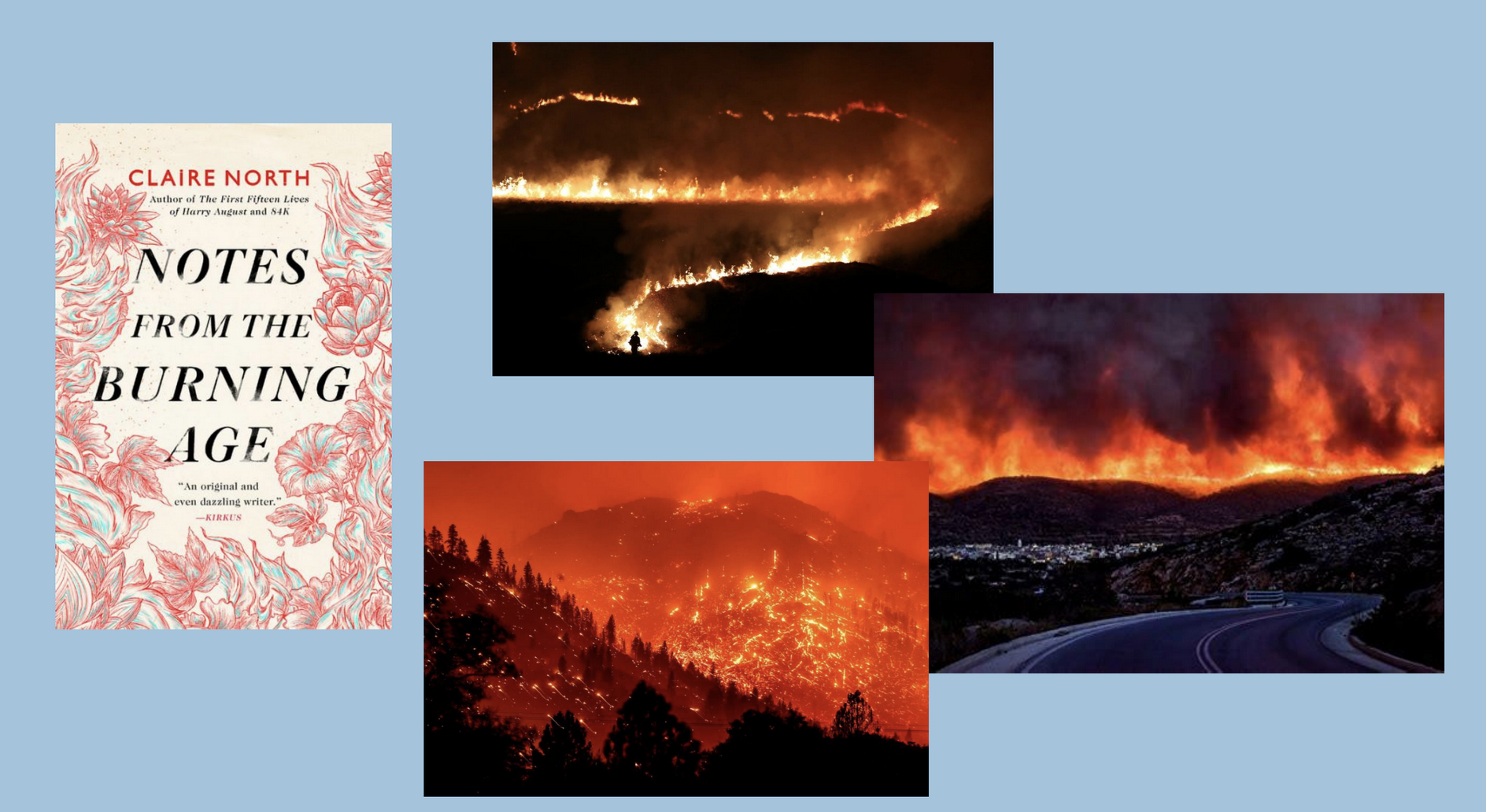
We are living in a time of perma crisis. Visible signs of climate breakdown are all around us. We are entering The Burning Age. Claire North’s novel Notes from the Burning Age imagines a far-distant future where the balance of life on Earth has changed. Climate breakdown has reduced and scattered the human population. Those who remain regroup and reform, living under a new system where tributes are paid to the gods of nature and the earth, the kakuy, to pacify them less they grow restive and return all of humankind to the Burning Age. They are taught:
Let not your hands fell the tree but that another is planted.
Let not your ears hear the rain and think it falls for you.
Let not your tongue speak of conquering the mountain, for it will not shiver when winter comes.
And if your eyes should see the kakuy slumbering in their sacred caves, gentle in rest, remember to bow in prayer, for should they wake again, no tears shall douse the flames.
The people of the novel live communal lives in unquiet harmony with other-than-human nature. Humans have been realigned to sit alongside others, their supposed position at the top of the Chain of Being toppled. But their tributes to the kakuy are predicated on fear, not love. The relationship is one of cowed and reluctant reverence rather than one of shared and mutual joy. There are those that seek to return humans to the top of the hierarchical tree. Fading fears are not enough incentive to stop those hungry for power in using any means to take it. The bad old days return…
As we face our current crisis, and as we think about our responsibility to future generations, we have a choice to make. Do we approach the future with fear, or with hope? Do we see the rest of nature as something to be mollified and overcome, or as something we can share a brighter future with. When we are surrounded by fear and anxiety, how can we hope to reframe and repair our relationship with the other-than-human world? How can we change from relationships of exploitation to ones predicated on respect and reciprocity? What ways of being can we look to for inspiration? In our divided world, where can we find spaces to encounter the ‘other’ that are safe for both us and for them? What alternative stories might we tell?
When we seek such spaces, we might look back into the past, seek to understand the roots of the present, and open our minds to imagining the future in unbounded and unrestricted ways. Working lowland common land in England is on the knife edge of this choice between exploitation and cooperation. Localised management, a deep sense of history, overriding love and care for these places, and the support of concerned citizens has allowed them to weather the ongoing storms of enclosure, privatisation, techno-industrial agriculture, and a changing climate. So far at least. But as these processes continue, commons come under increasing pressure. From people, seeking to reconnect with other-than-human nature. From farmers, who are ill-supported in their attempts to maintain a commoning way of life in a neo liberal economy. From cars. From climate change. From funding cuts… The list goes on. But they do persist, and people are passionate in their defence of them. The traditional commons notion of operating in ‘good neighbourhood’ persists. It morphs and flexes, but fundamentally it persists.

Jean Jacques Rousseau links the ills of humankind to the drive to ‘own’ land, to enclose it, to possess it. In this quotation, he talks of wars, crimes, murder, and misery and lays these at the door of the human urge to own land. He only reflects however on the ills caused to the human race. In our modern understanding, we might add to this the untold horrors caused to the other-than-human world as a result of this urge to possess and to exploit. Common land in England is of course ‘owned’. Perhaps more than any other land type however, there is a sense that this ownership is shared. People are more aware of their rights on this land than they are on others. Inherited senses of the injustices wrought by enclosure are alive and well and are often directed at those who try to visibly ‘manage’ the land. Conservation efforts that seek to balance the need of humans, with the often-rare other species that live on commons, can meet with resistance and hostility. We are too much squeezed into the same spaces. The notion of good neighbourhood concerns humans alone, and goodness knows, humans have enough trouble managing their own conflicting priorities. The understanding that rights to share in the gifts of the land came with obligations has become diluted. Sometimes, the idea of extending this principle to other-than-humans seems an impossible task. Some deeper recognition of others as kin, when that word didn’t just mean to those whom you were directly related, is needed. We need to undertake our hierarchical realignment from choice, not from fear.
Places such as Rodborough Common offer sites of sharing, models of a different way of being with the land, and with each other, and provide a springboard for the kind of imaginative storytelling that can help us to reframe human and other-than-human relations. They can provide contact zones, places to encounter the ‘other’, particularly when they occupy the margins between the urban and rural. I’m now going to take you on a whistle stop tour of Rodborough Common. We will start in deep time, and come right up to the present day. I hope that my story will help you to picture this place, and to situate its human protagonists alongside those who were party to its co-creation.
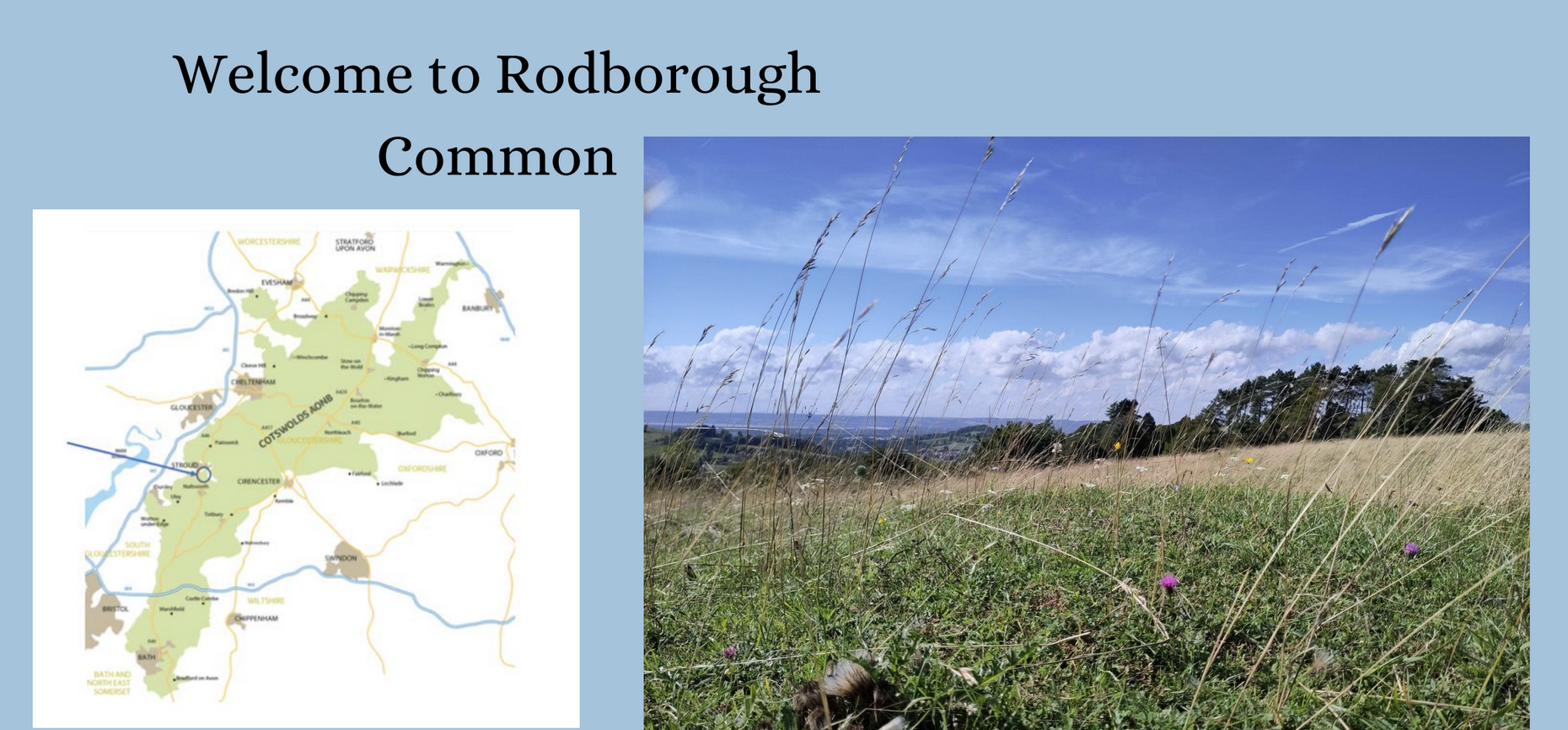
Rodborough Common forms part of the escarpment of Jurassic limestone known in modern times as the Cotswolds. It lies in western England above the market town of Stroud, and commands fine views over the River Severn into Wales. It is currently ‘owned’ by the National Trust and is still actively commoned. Just about. Out of the more than 200 properties with common rights registered, only 2 are actively still farming here.
This land has its origins in deep time. It once sat under the waves of a warm, shallow, sea that supported a multitude of life. Its countless creatures and plants lived and died; their bodies becoming part of the land itself. Through the pushes and pulls of the ice ages, it was heaved apart from the land of the Severn Vale to form a spiny backbone that runs along England’s western border with Wales. When you walk on Rodborough Common, you walk on the graves of countless millions. If you look carefully you can still see them, close to the surface, within arms reach.
When the ice retreated, trees colonised the land, and large herbivores came in their wake. The soils of Rodborough are shallow and thin. Trees grow but do not always thrive here. As humans began to settle, some trees were cleared. Wood pasture habitat likely developed.
A documented tradition of commoning goes back at least 700 years here, but it is likely that communal farming was practised long before that. Rodborough’s commoners used the Celtic system of a series of sub-fee manors, a system that we would find more familiar than the Anglo-Saxon method of farming communally in strips, that is better known under the mediaeval system.
For the common, trees were present in large numbers until the 17th century. The area of grassland that is now so valuable for its biological rarity was once the custom wood. Wardens of the Wood were appointed across the generations. The axe bearer as he was known, marked the trees for harvest, not felling, and ensured that no one took more than their share. At one time, the woodland supported more than 3000 swine. The swineherd was an important position with special benefits. Alongside, farmed and free-living animals evolved and co-operated in conjunction with human endeavours.
As geo-political Britain expanded and reached beyond its shores, Rodborough’s use evolved. Neighbouring Stroud was heavily employed in producing woollen cloth and dying it scarlet for the use of Britain's colonising armies. Sheep came to Rodborough. The trees retreated. The chalk grassland for which it is now so valued, was born. Cattle, goats, horses, all grazed on the common. Humans settled here, some temporarily, others permanently. Some areas were enclosed, but encroachments were quickly and decisively dealt with. Good neighbourhood survived the onslaught of greedy landowners, indifferent, absent, landlords and increased quarrying of its much prized stone. These defences were often made on the basis of rights that were understood to have been in place since ‘time immemorial’.
As human society changed, and as leisure became more accessible, Rodborough’s purpose evolved too. It was an important place to meet, to convene, to encounter your neighbours, human and otherwise, for high days and holidays. May Day processions, beating the bounds, and Midsummer Eve were all important dates in the local calendar. The commons around Stroud were also used for religious meetings of the non-conformist church, for political meetings of the Chartists. In short, they provided a vital space for the community to gather unhindered.
These uses are still important today. During the pandemic the commons became vital places for people to meet within the restrictions placed on them. Wakes were held here, wedding celebrations, birthday parties and family reunions. As the world reopened, we remembered what was important to us; family, friends, air, space. But the others who share the common with us did not benefit from this remembering. As more people come, paths widen. Cattle are bothered by dogs. Traffic speeds. Skylarks are flushed from their nests. In our isolation, we forgot how to share.

If Rodborough Common had a human voice, what might it say of the present day? One might imagine that it would scoff at claims of rights and ownership of mere hundreds of years standing. That ‘time immemorial’ would have a very different definition to it than it does to us. It might also tell us that change is inevitable and that time never stands still. It has borne witness to exploitation and plunder; of its rock, its grassland, its trees. But it has also seen humans and other than humans living in balance and harmony. It has seen how effectively that balance can be maintained. It is living, breathing, evolving proof, that sharing is possible, that mutual thriving can be achieved.
So I invite you to imagine the future of places like Rodborough Common. But to do this from a starting point of hope, joy, and wonder. Not one of fear. Of understanding that enduring models of sharing and reciprocity are both possible and desirable. To imagine a future where the principles of good neighbourhood can be revived, refreshed, and renewed. And most importantly extended to our other-than-human kin.
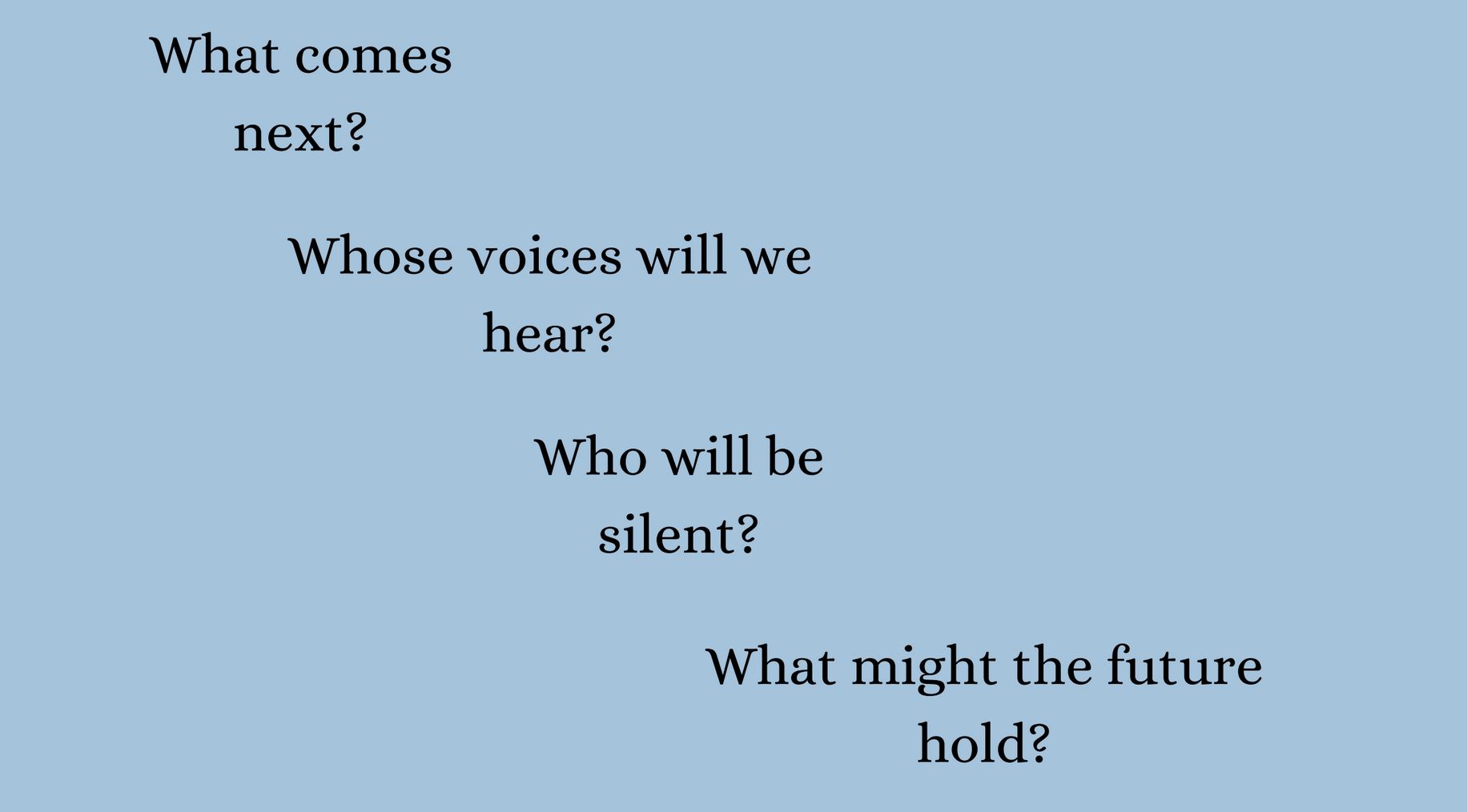
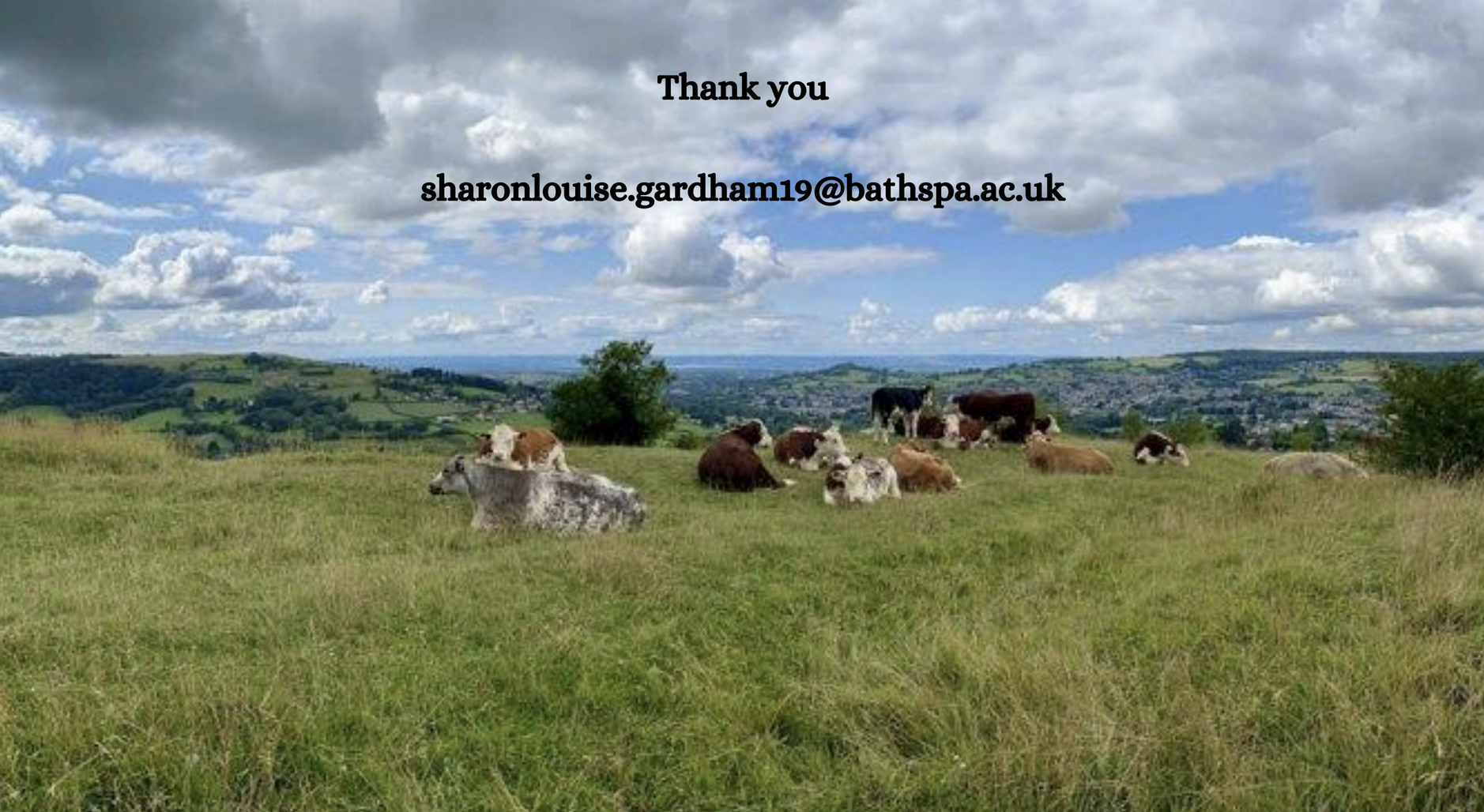
Traduction en français
Traduction libre par Marie-Soleil L’Allier
Bonjour et bon après-midi. Je m'appelle Sharon Gardham et je suis dans ma dernière année de recherche doctorale à l'université Bath Spa. Mon projet intitulé « Sur le soin de nos biens communs : revitaliser et étendre la notion de bon voisinage pour les biens communs modernes des Cotswolds » s'inscrit dans les disciplines des Humanités Environnementales. Il utilise la recherche historique, l'analyse du discours d'entretiens semi-structurés et l'auto-ethnographie pour examiner les relations humaines et non humaines. J'ai mené une étude de cas sur un bien commun en activité dans les basses terres de l'Ouest de l'Angleterre. Je m'intéresse particulièrement au pouvoir de l'imagination et du storytelling pour nous aider à imaginer des relations différentes avec les non-humains et à nous libérer des contraintes des discours dominants. Je m'intéresse également au potentiel des terres communes en activité pour remettre en question les idées ancrées concernant la propriété, l'utilisation et le partage des terres. En parallèle de mes études, je travaille pour une association environnementale locale, où je participe à des programmes de conservation active et à des projets d'engagement public.
Nous vivons à une époque de crise permanente. Les signes visibles de l'effondrement climatique sont tout autour de nous. Nous entrons dans l'Âge Brûlant. Le roman de Claire North, Notes from the Burning Age, imagine un futur lointain où l'équilibre de la vie sur Terre a changé. L'effondrement climatique a réduit et dispersé la population humaine. Ceux qui restent se regroupent et se réforment, vivant sous un nouveau système où des tributs sont payés aux dieux de la nature et de la terre, les kakuy, pour les pacifier afin qu'ils ne deviennent pas agités et ne ramènent pas toute l'humanité à l'Âge Brûlant. Ils apprennent :
Que vos mains ne coupent l'arbre qu'après en avoir planté un autre.
Que vos oreilles n'entendent pas la pluie et pensent qu'elle tombe pour vous.
Que votre langue ne parle pas de conquérir la montagne, car elle ne tremblera pas quand l'hiver viendra.
Et si vos yeux voient les kakuy dormant dans leurs grottes sacrées, doux au repos, souvenez-vous de vous incliner en prière, car s'ils se réveillent à nouveau, aucune larme n'éteindra les flammes.
Les gens du roman vivent des vies communautaires en harmonie agitée avec la nature non humaine. Les humains ont été réalignés pour s'asseoir aux côtés des autres, leur position supposée au sommet de la chaîne de l'être étant renversée. Mais leurs tributs aux kakuy sont fondés sur la peur, et non sur l'amour. La relation est une révérence craintive et réticente plutôt qu'une joie partagée et mutuelle. Certains cherchent à ramener les humains au sommet de l'arbre hiérarchique. Les peurs qui s'estompent ne suffisent pas à empêcher ceux qui ont faim de pouvoir d'utiliser tous les moyens pour le prendre. Les mauvais jours reviennent...
Alors que nous faisons face à notre crise actuelle, et que nous réfléchissons à notre responsabilité envers les générations futures, nous avons un choix à faire. Abordons-nous l'avenir avec peur ou avec espoir ? Voyons-nous le reste de la nature comme quelque chose à apaiser et à surmonter, ou comme quelque chose avec lequel nous pouvons partager un avenir plus radieux ? Lorsque nous sommes entourés de peur et d'anxiété, comment pouvons-nous espérer reformuler et réparer notre relation avec le monde non humain ? Comment pouvons-nous passer de relations d'exploitation à des relations fondées sur le respect et la réciprocité ? Quels modes de vie pouvons-nous regarder pour nous inspirer ? Dans notre monde divisé, où pouvons-nous trouver des espaces pour rencontrer l'autre qui soient sûrs pour nous et pour eux ? Quelles histoires alternatives pourrions-nous raconter ?
Lorsque nous cherchons de tels espaces, nous pouvons regarder en arrière dans le passé, chercher à comprendre les racines du présent, et ouvrir nos esprits à imaginer l'avenir de manière illimitée et sans restriction. Les terres communes de plaine en Angleterre sont sur le fil du rasoir entre l'exploitation et la coopération. La gestion localisée, un profond sens de l'histoire, un amour et un soin prépondérants pour ces lieux, et le soutien des citoyens concernés leur ont permis de résister aux tempêtes continues de l'enclosure, de la privatisation, de l'agriculture techno-industrielle et du changement climatique. Jusqu'à présent, du moins. Mais à mesure que ces processus se poursuivent, les communs sont de plus en plus sous pression. De la part des gens, cherchant à se reconnecter avec la nature non humaine. Des agriculteurs, mal soutenus dans leurs tentatives de maintenir un mode de vie en commun dans une économie néolibérale. Des voitures. Du changement climatique. Des coupes budgétaires... La liste est longue. Mais ils persistent, et les gens sont passionnés dans leur défense. La notion traditionnelle de bon voisinage persiste. Elle se transforme et se fléchit, mais fondamentalement, elle persiste.
Jean Jacques Rousseau lie les maux de l'humanité à la volonté de « posséder » la terre, de l'enclore, de la posséder. Dans cette citation, il parle de guerres, de crimes, de meurtres et de misère et les attribue à l'instinct humain de posséder la terre. Cependant, il ne réfléchit qu'aux maux causés à la race humaine. Dans notre compréhension moderne, nous pourrions ajouter à cela les horreurs indicibles causées au monde non humain en raison de cette volonté de posséder et d'exploiter. Les terres communes en Angleterre sont bien sûr « possédées ». Peut-être plus que tout autre type de terre, il y a un sentiment que cette possession est partagée. Les gens sont plus conscients de leurs droits sur cette terre que sur d'autres. Les sentiments hérités des injustices causées par l'enclosure sont vivants et bien présents et sont souvent dirigés contre ceux qui tentent de « gérer » visiblement la terre. Les efforts de conservation qui cherchent à équilibrer les besoins des humains avec les espèces souvent rares qui vivent sur les communs peuvent rencontrer de la résistance et de l'hostilité. Nous sommes trop nombreux à être entassés dans les mêmes espaces. La notion de bon voisinage concerne uniquement les humains, et Dieu sait que les humains ont déjà suffisamment de mal à gérer leurs propres priorités conflictuelles. La compréhension que les droits de partage des dons de la terre s'accompagnent d'obligations s'est diluée. Parfois, l'idée d'étendre ce principe aux non-humains semble une tâche impossible. Une reconnaissance plus profonde des autres en tant que parents, lorsque ce mot ne se limitait pas seulement à ceux auxquels vous étiez directement liés, est nécessaire. Nous devons entreprendre notre réajustement hiérarchique par choix, et non par peur.
Des lieux comme Rodborough Common offrent des sites de partage, des modèles d'une manière différente d'être avec la terre et les uns avec les autres, et fournissent un tremplin pour le genre de storytelling imaginatif qui peut nous aider à reformuler les relations entre les humains et les non-humains. Ils peuvent fournir des zones de contact, des lieux pour rencontrer l'autre, en particulier lorsqu'ils occupent les marges entre l'urbain et le rural. Je vais maintenant vous emmener dans un tour rapide de Rodborough Common. Nous commencerons dans le temps profond, et arriverons jusqu'à aujourd'hui. J'espère que mon histoire vous aidera à imaginer ce lieu, et à situer ses protagonistes humains aux côtés de ceux qui ont participé à sa co-création.
Rodborough Common fait partie de l'escarpement de calcaire jurassique connu de nos jours sous le nom de Cotswolds. Il se trouve dans l'ouest de l'Angleterre, au-dessus de la ville de marché de Stroud, et offre de belles vues sur la rivière Severn jusqu'au Pays de Galles. Il est actuellement « possédé » par le National Trust et est encore activement commun. Juste à peu près. Sur les plus de 200 propriétés enregistrées avec des droits communs, seules 2 sont encore en activité ici.
Cette terre a ses origines dans le temps profond. Elle se trouvait autrefois sous les vagues d'une mer chaude et peu profonde qui soutenait une multitude de vies. Ses innombrables créatures et plantes ont vécu et sont mortes ; leurs corps faisant partie intégrante de la terre elle-même. À travers les poussées et les tractions des âges glaciaires, elle a été séparée de la terre de la vallée de la Severn pour former une colonne vertébrale épineuse qui s'étend le long de la frontière ouest de l'Angleterre avec le Pays de Galles. Lorsque vous marchez sur Rodborough Common, vous marchez sur les tombes de millions d'êtres. Si vous regardez attentivement, vous pouvez encore les voir, près de la surface, à portée de main.
Lorsque la glace a reculé, les arbres ont colonisé la terre, et les grands herbivores ont suivi. Les sols de Rodborough sont peu profonds et minces. Les arbres y poussent mais ne prospèrent pas toujours. À mesure que les humains ont commencé à s'installer, certains arbres ont été abattus. L'habitat de pâturage forestier s'est probablement développé.
note Note(s) liée(s)
 3 juin 2024
3 juin 2024
Sharon Gardham
3 juin 2024 12 juin 2024
12 juin 2024
Presentation of the notebook | Commoning beyond growth
12 juin 2024 21 février 2024
21 février 2024
Marie-Soleil L’Allier s'intéresse aux communs
21 février 2024Carnet(s) relié(s)
 file_copy
61 notes
file_copy
61 notes
Commoning Beyond Growth
file_copy 61 notesAuteur·trice(s) de note
Contacter l’auteur·triceCommunauté liée
Commoning Beyond Growth
Plus d’informationsPublication
18 juin 2024
Modification
20 juin 2024 17:42
Licence
Attention : une partie ou l’ensemble de ce contenu pourrait ne pas être la propriété de la, du ou des auteur·trices de la note. Au besoin, informez-vous sur les conditions de réutilisation.
Visibilité
public
Pour citer cette note
Marie-Soleil L'Allier. (2024). On Care of our Commons Home: Storying the Commons. Praxis (consulté le 18 juillet 2024), https://praxis.encommun.io/n/c7_Faz3UtnxYX0zdFHsQHgJ93ng/.
shareCopier